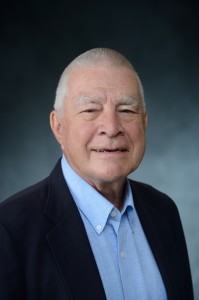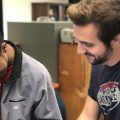When Sam DeLeeuw came to the University of Mississippi in 1965, the only person he knew other than family was Karl Brenkert. As the new dean of the School of Engineering, Brenkert had recruited DeLeeuw from Yale University to join the UM faculty as chair and professor of civil engineering.
“Karl was one of my professors at Michigan State University,” DeLeeuw said. “He was a great professor, but he was an even better friend to me. Upon his recommendation, I interviewed for the position, was offered and accepted the job. I’ve never regretted my decision.”
Over the course of his 30-year tenure at Ole Miss, DeLeeuw quickly and steadily earned the respect of his colleagues, the admiration of his students and the enduring friendship of alumni. Combining the science of engineering with his own unique wit and amicable personality, he favorably impressed the people around him.
“I think a lot of Sam,” said Russell Aven, chair and professor emeritus of chemical engineering and a longtime friend of DeLeeuw. “He was always cheerful and good to be around. He did a very good job as chairman of the civil engineering department and managed to liven up any committee meeting we were in together with his humor.”
DeLeeuw met William “Bill” Rigby, one of his students, in 1966. They have remained close for more than 42 years.
“My most vivid memory of him was midway through my student career,” Rigby said. “The Ole Miss ASCE group was to attend a conference at LSU. We had a van to take us. However, I had to participate in a band concert that prevented my riding the van. Dr. DeLeeuw stayed back until the concert was over and then drove me to the event.”
After graduating from Ole Miss is 1971, Rigby and DeLeeuw stayed in contact, first through the mail and then by email. DeLeeuw mentored Rigby through a 28-year Navy civil engineer corps career and then provided useful advice as he entered the private sector.
“His influence on my life and career is immeasurable. It is my honor to have known him, studied under him and claim his friendship,” Rigby said.
Though he was a leader himself, DeLeeuw followed Brenkert’s direction when it came to instruction.
“Karl wanted the faculty to move away from the mechanics of engineering and into the science of it,” he said. “His philosophy was ‘technology changes, procedures change, but science is at the core of it all.’ Students who obtain that core can apply themselves to any technology.
“It was a new approach, but by following it we succeeded in moving engineering at the university to a higher level of prominence.”
While DeLeeuw embraced theory, he never lost sight of the value of exposing his students to practicing engineers.
“I put a lot of emphasis on field trips,” he said. “When the Tennessee-Tombigbee Waterway was under construction, I took a group to tour the site every year for three to four years. We’d frequently attend meetings of the Mississippi section of the American Society of Civil Engineers in Jackson and Vicksburg. While there, we’d visit construction sites as well.”
DeLeeuw and his students also traveled out of state on several occasions.
“We went to see the construction of the Pyramid in Memphis, the construction of the World’s Fair site in New Orleans, the skyscraper construction in Houston, Texas, and the Braves’ baseball stadium in Atlanta,” he said.
Charles “Chuck” Jenkins also remembers time spent with his former teacher and friend.
“Sam DeLeeuw — like his mentor, Karl Brenkert, before him — is a gem of a fellow who devoted himself to his students and to all aspects of engineering education, not just the learning that occasionally occurs in the classroom,” Jenkins said. “I reconnected with Sam after I returned to Oxford in 1993, when I found him standing on the hill overlooking Swayze Field, taking in a baseball game on a beautiful afternoon. With our mutual appreciation for beer and baseball, we began a friendship that continues 20 years later.”
Jenkins and DeLeeuw attend the same church, root for some of the same teams, tailgate together, enjoy the occasional adult beverage together and, lately, walk through tough times together.
“Universally loved, Sam has many friends, and I consider him my closest friend,” Jenkins said.
Back in the classroom, DeLeeuw’s favorite civil engineering course to teach had little to do with designs and equations.
“The course was called Professionalism in Civil Engineering,” he said. “In it, I covered ethics, the history of civil engineering and how students could improve their writing and speaking skills. It was my most enjoyable class.”
Two standing commitments that DeLeeuw maintains are the MATHCOUNTS competition for middle and high school students and the concrete canoe design and racing contest. He shared his reflections about each.
“I had run a balsa wood modeling contest for high school students 10 years before I took over MATHCOUNTS,” DeLeeuw said. “I guess that’s why when the Mississippi Engineering Society asked me to coordinate the event, I agreed.
“As for the concrete canoes, it all began when our students challenged students at Mississippi State to a race. Their entry was lighter and nicer looking than ours, but we had a secret weapon in Jim Walcott and Robert Arnold. Those guys knew how to canoe better than those from State, and they won the race for us. It just grew and grew from there.”
In 1987, DeLeeuw stepped down as chair of the department. Nine years later, he retired from the university and became chair and professor emeritus of civil engineering.
“Even though I’d burned out on teaching, the first year after I retired, I would still visit campus once a week just to check on things,” he said.
Upon one such visit, DeLeeuw met Christopher Mullen, who replaced him as chair of the civil engineering department. Mullen was immediately struck by his predecessor’s quick wit, which has provided many memories.
“One of the first I remember is his noting upon my arrival at Ole Miss of the nature of a true Ph.D. dissertation. ‘At Yale,’ he said, ‘one of the first, if not the first, dissertation was a single page in length,’” Mullen said. “Fresh from a Ph.D. at Princeton, where mine was only 100 pages or so, I felt I had to respond. But, alas, I am not as gifted as he and could not think of a proper retort.”
DeLeeuw is a wonderful role model for engineers, Ole Miss students and himself, Mullen said.
“He is warmhearted, interested in all things and always involved in some form of serving others. In some respects, Sam has many of the qualities I remember and admire in my own father.”
Gradually, DeLeeuw’s visits tapered off to his becoming a guest lecturer on occasion.
“I spent a lot of time taking care of my wife (Nancy), who passed last year,” DeLeeuw said. “I’m also spending a lot of time with my grandchildren, great-grandchildren and friends.”
A native of Grand Rapids, Mich., DeLeeuw earned his bachelor’s, master’s and doctoral degrees from Michigan State University. Before coming to UM, he was assistant professor of engineering at Yale.

